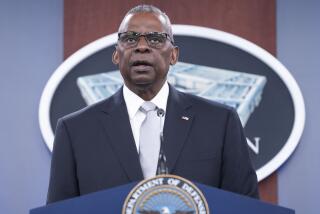Cheney View: ‘Saddam Won’t Be Around Long’ : Iraq: The Administration pledges to keep the heat on Hussein’s regime. Bush hails Gulf War achievements.
- Share via
WASHINGTON — A year after the start of the Persian Gulf War, the Bush Administration vowed Thursday to keep the pressure on Iraqi President Saddam Hussein until he leaves power, an event Defense Secretary Dick Cheney predicted will occur “in the not-too-distant future.”
“My own personal view is that Saddam won’t be around very long. . . . I think he’s had to conduct purges and is relying on an ever-shrinking base of support within his own security services,” Cheney said in one of four television interviews he conducted Thursday morning to mark the first anniversary of the war that drove occupying Iraqi forces from Kuwait.
His statement was the strongest on the subject by such a high-ranking official.
In an announcement timed to the anniversary, the Air Force lifted another veil from its complex aerial attack on Iraq and revealed that it had used a secret, air-launched cruise missile in the assault on Iraqi defenses. It said that B-52 bombers, flying from a U.S. air base, launched a total of 35 conventional cruise missiles at eight Iraqi targets on the opening night of the air war.
Until this disclosure, the only known conventional weapons carried by B-52s were standard, unguided iron bombs. The attack, in which seven of the bombers launched conventionally armed versions of a long-deployed nuclear weapon, marked the first use of the previously secret weapons.
The new weapon, called the AGM-86C, can be fired at targets from miles outside an adversary’s air defenses and is designed to fly to its destination using an internal computer program and satellite guidance. While Navy ships and submarines launched weapons that work similarly, the Air Force has never before acknowledged that it had such weapons.
Pentagon spokesman Pete Williams said the Air Force believes its cruise missiles had a potent effect against Iraqi electrical generating plants, transmission facilities and military communications sites.
Roughly 12 hours before the first strikes on Baghdad, the B-52s left Barksdale Air Force Base in Louisiana, at 4:35 PST on the morning of Jan. 16, 1991, and with refueling flew 14,000 miles to complete their mission. The round trip and time over the target made it the longest single air combat mission in history, Williams said.
In future operations, the Air Force weapon could be used to perform many of the same missions now conducted by manned aircraft in circumstances where thick air defenses would risk pilots’ lives. Some experts believe that such weapons represent a cheap alternative to weapons such as the B-2 bomber, which is designed to penetrate air defenses to reach its target.
In a written statement, President Bush saluted the achievements of the U.S. forces in the war, which he said made secure “a critical region of the world,” and encouraged efforts inside and outside of Iraq to resist Hussein’s rule.
More to Read
Sign up for Essential California
The most important California stories and recommendations in your inbox every morning.
You may occasionally receive promotional content from the Los Angeles Times.











